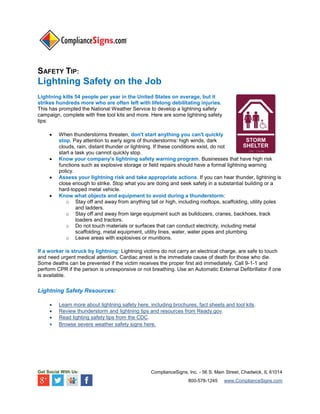Safety Tip: Lightning Safety on the Job
- 1. SAFETY TIP: Lightning Safety on the Job Lightning kills 54 people per year in the United States on average, but it strikes hundreds more who are often left with lifelong debilitating injuries. This has prompted the National Weather Service to develop a lightning safety campaign, complete with free tool kits and more. Here are some lightning safety tips: ď‚· When thunderstorms threaten, don't start anything you can't quickly stop. Pay attention to early signs of thunderstorms: high winds, dark clouds, rain, distant thunder or lightning. If these conditions exist, do not start a task you cannot quickly stop. ď‚· Know your company's lightning safety warning program. Businesses that have high risk functions such as explosive storage or field repairs should have a formal lightning warning policy. ď‚· Assess your lightning risk and take appropriate actions. If you can hear thunder, lightning is close enough to strike. Stop what you are doing and seek safety in a substantial building or a hard-topped metal vehicle. ď‚· Know what objects and equipment to avoid during a thunderstorm: o Stay off and away from anything tall or high, including rooftops, scaffolding, utility poles and ladders. o Stay off and away from large equipment such as bulldozers, cranes, backhoes, track loaders and tractors. o Do not touch materials or surfaces that can conduct electricity, including metal scaffolding, metal equipment, utility lines, water, water pipes and plumbing. o Leave areas with explosives or munitions. If a worker is struck by lightning: Lightning victims do not carry an electrical charge, are safe to touch and need urgent medical attention. Cardiac arrest is the immediate cause of death for those who die. Some deaths can be prevented if the victim receives the proper first aid immediately. Call 9-1-1 and perform CPR if the person is unresponsive or not breathing. Use an Automatic External Defibrillator if one is available. Lightning Safety Resources: ď‚· Learn more about lightning safety here, including brochures, fact sheets and tool kits. ď‚· Review thunderstorm and lightning tips and resources from Ready.gov. ď‚· Read lighting safety tips from the CDC. ď‚· Browse severe weather safety signs here. Get Social With Us: ComplianceSigns, Inc. - 56 S. Main Street, Chadwick, IL 61014 800-578-1245 www.ComplianceSigns.com

